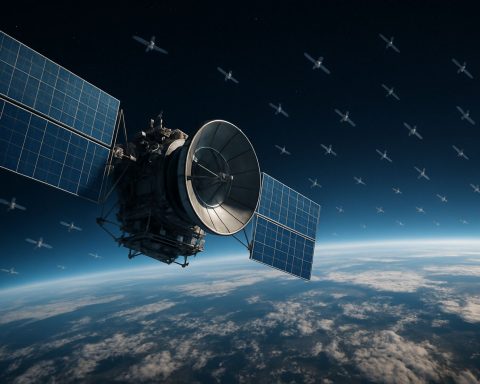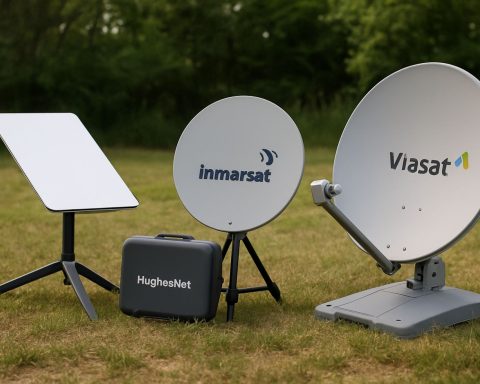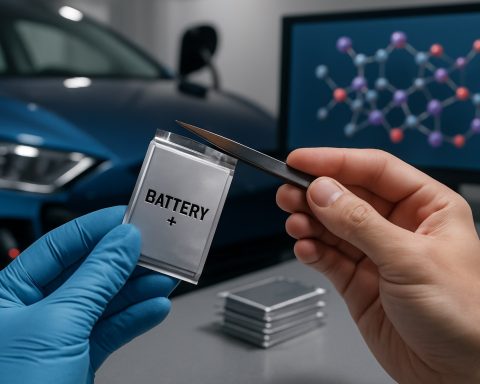- Pioneering research from the University of Michigan enables EV batteries to charge five times faster in cold weather.
- The breakthrough addresses the slow charging issue caused by sluggish lithium-ion movement in freezing temperatures.
- A novel 20-nanometer lithium borate-carbonate glassy coating prevents chemical barriers, enhancing ion flow.
- Modified EV batteries retain 97% capacity over 100 fast-charge cycles at low temperatures.
- Collaboration with Arbor Battery Innovations aims to commercialize the technology.
- The advancement promises improved cold-weather performance, encouraging broader adoption of EVs.
A bone-chilling wind sweeps over an icy landscape, where electric vehicles (EVs) sit quietly, their owners lamenting the sluggish charging times exacerbated by the frigid air. Such winter woes may soon become relics of the past, thanks to a pioneering development from the cutting-edge labs of the University of Michigan.
A team of industrious engineers, led by Neil Dasgupta, an associate professor of mechanical engineering and materials science, have unlocked the secret to charging EV batteries at five times the usual speed—even when the mercury plummets to a toe-numbing 14F (-10C). The breakthrough, rooted in the pages of the journal Joule, offers hope to those tired of waiting up to an hour merely to get their vehicles back on the road during the cold months.
The central issue for EVs in cold weather is akin to trying to cut through a block of cold butter—thick and unyielding. Temperatures drop, lithium ions dawdle across battery terminals, and charging times elongate painfully. The solution devised by Dasgupta and his cohort involves a metallic symphony of structural innovation and ultra-thin coatings. They’ve intricately crafted pathways within the battery anode, allowing ions to glide more freely into the depths of the device.
However, the real game-changer lies in a delicate, 20-nanometer glove—a simple, yet sophisticated glassy coating made from lithium borate-carbonate. By thwarting the formation of a chemical barricade on the electrodes, this solution opens a freeway for ions to charge the battery efficiently, even as snowflakes dance and temperatures refuse to rise.
Post this invention, the modified batteries triumphantly retained 97% of their capacity over 100 fast-charge cycles, despite the low temperatures—a promising statistic that sets a new benchmark for EV performance. The achievement is not just about faster charging; it heralds a new era for EV adoption, potentially shredding one of the last barriers for would-be buyers who fear winter’s chill.
Now, as the tireless minds at U-M work alongside partners like Arbor Battery Innovations to bring this technology from blueprint to blacktop, the horizon looks bright for EV technology. With backing from initiatives such as the Michigan Translational Research and Commercialization program, this breakthrough is on the fast track to commercialization.
For many, the notion of cold-weather performance in EVs has been less a question of if than when. With these advancements, the “when” is drawing tantalizingly close, as EV owners and prospective buyers look forward to the day when winter no longer dictates the terms of their electric journeys. As the technology advances, it promises to redefine the way we think about the symbiotic relationship between technology and climate, making the promise of a sustainable future ever more attainable.
The Revolutionary EV Breakthrough: Charge at Lightning Speed Even in Arctic Conditions
Fast-Tracking the Future of Electric Vehicles in Cold Climates
Electric vehicles (EVs) have become a symbol of clean energy and innovation. However, one of the persistent challenges they face is maintaining efficient performance in cold weather. Recent strides from the University of Michigan, guided by Neil Dasgupta and his team, aim to resolve this issue with a revolutionary battery technology that allows EVs to charge at unprecedented speeds, even when temperatures plunge to 14°F (-10°C).
New Insights on EV Battery Technology
– Structural Innovation: The team has tackled the sluggish movement of lithium ions in cold conditions. By redesigning the pathways within the battery anode, the ions can move more swiftly, akin to clearing a highway jam. This structural change is a crucial component in reducing charging times.
– Innovative Glassy Coating: The introduction of a 20-nanometer glassy coating made from lithium borate-carbonate prevents the formation of chemical barriers on electrodes. This essential feature facilitates an unobstructed path for ions during the charging process.
– Durability and Longevity: The modified batteries exhibit remarkable durability, retaining 97% of their capacity across 100 fast charges in low-temperature environments. This is a vital factor in enhancing customer confidence in EVs during winter months.
The Broader Implications for EV Adoption
The technological advancement outlined above not only aids current EV owners but also addresses some of the hesitations potential buyers have concerning EVs.
– Market Forecast and Trends: The push for faster charging EVs is likely to bolster the market, encouraging more consumers to switch, particularly in colder climates. According to industry predictions, the global EV market is expected to grow exponentially as charging infrastructure and battery technologies continue to improve.
– Sustainability and Performance: As these batteries hit the market, they promise to reduce the environmental impact by reducing idle charging time and energy consumption. The greater efficiency supports a more sustainable automotive industry, aligning with global goals for carbon reduction.
Questions and Answers on EV Winter Performance
– How do cold temperatures affect current EVs?
Cold weather can significantly decrease the range and extend charging times due to slower lithium ion movement and increased energy demands for heating.
– What makes this new technology different?
The structural innovations and the glassy coating eliminate classical barriers, allowing faster and more efficient ion movement, significantly enhancing performance, especially in cold climates.
Practical Steps and Quick Tips
– Battery Care in Cold Weather: Until these advanced batteries are widespread, current EV owners can maximize their vehicle’s performance by preconditioning the battery before driving and using energy-saving driving modes.
– Stay Informed: Keep abreast of developments from manufacturers likely to adopt this technology. Early adoption may offer benefits such as incentives on nascent tech-equipped vehicles.
For more on EV innovation and sustainability, visit the official sites of [University of Michigan](https://umich.edu) and follow energy advancements in global automotive trends.
These breakthroughs promise to make electric vehicles more accessible and reliable in various climates, speeding the transition towards a greener automotive future.









